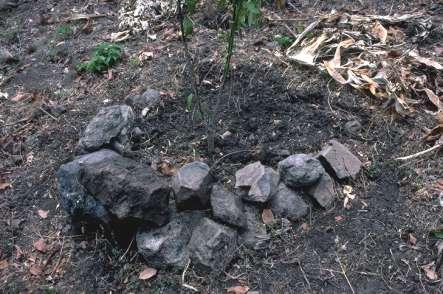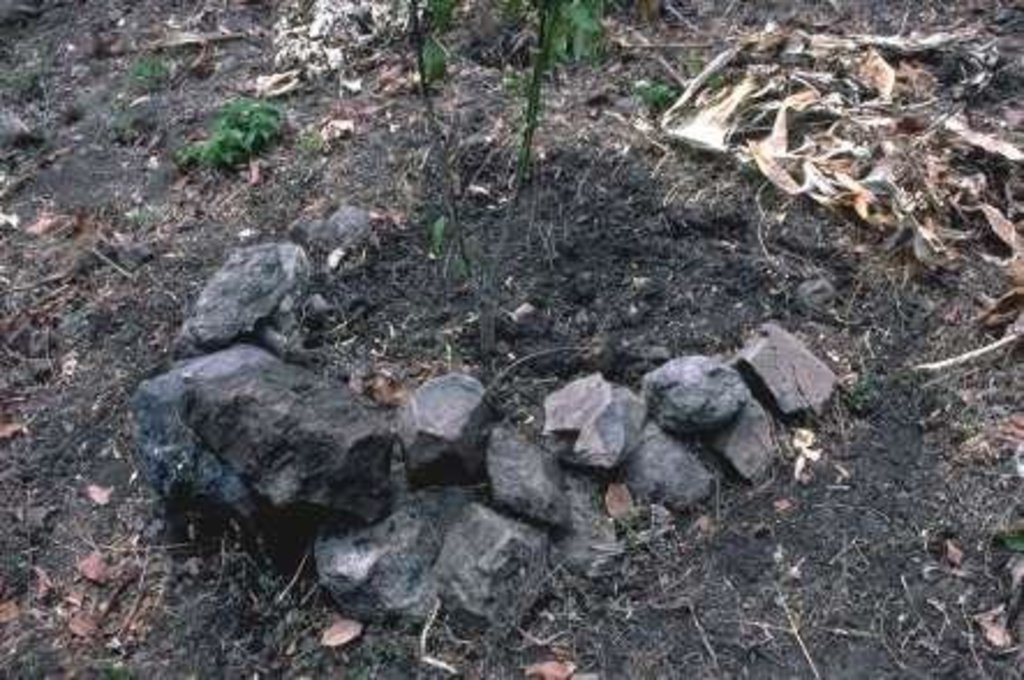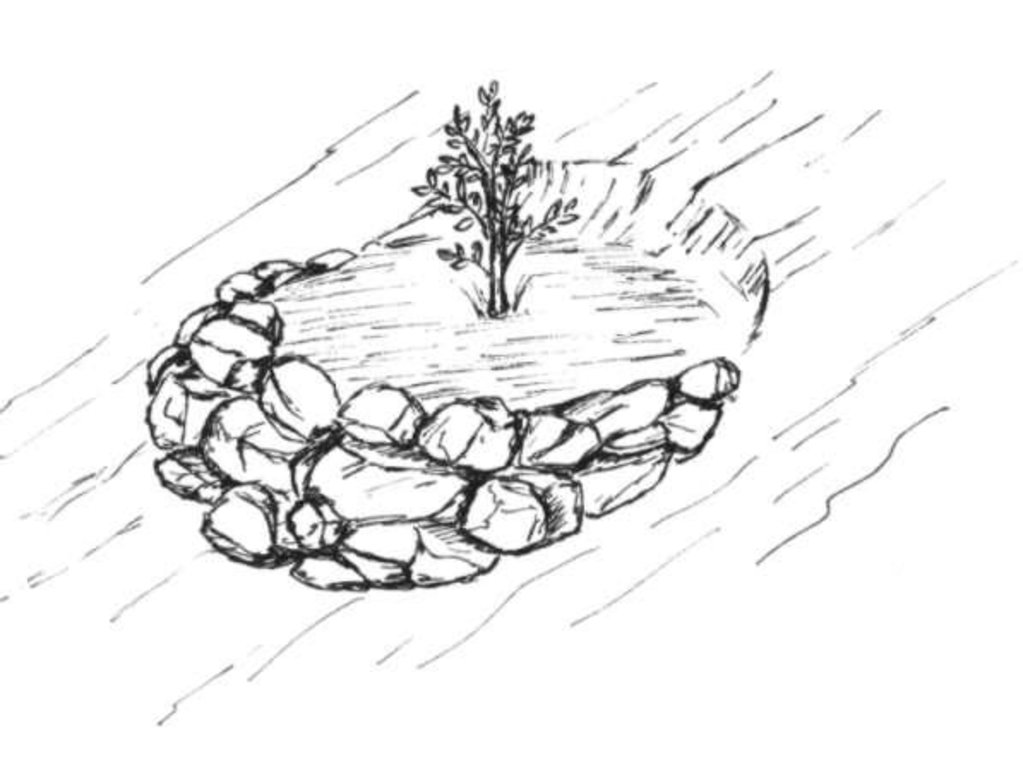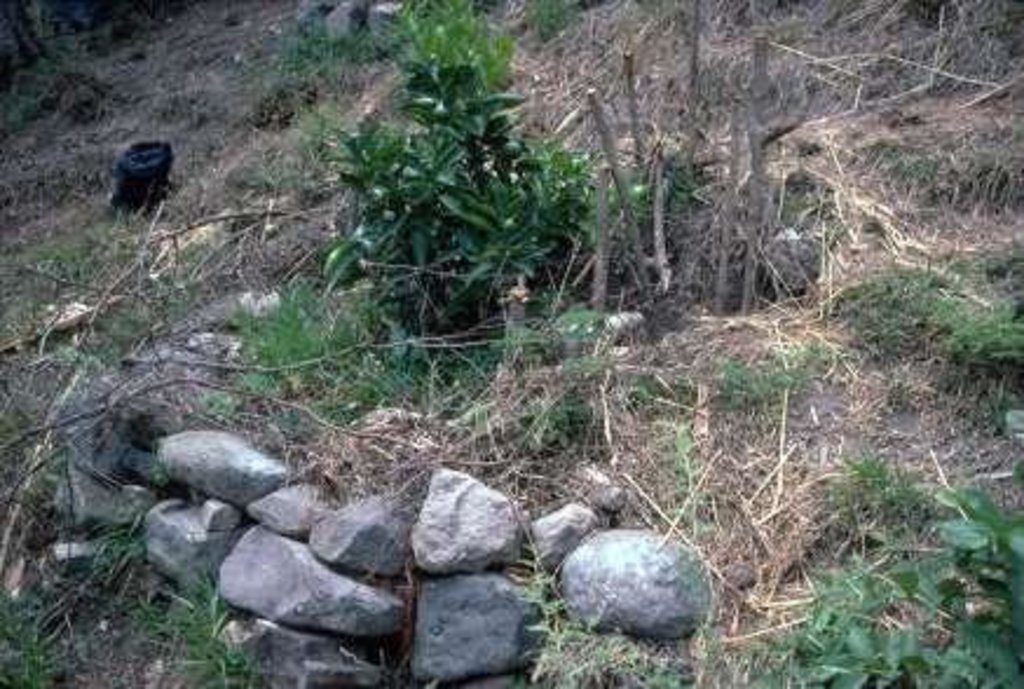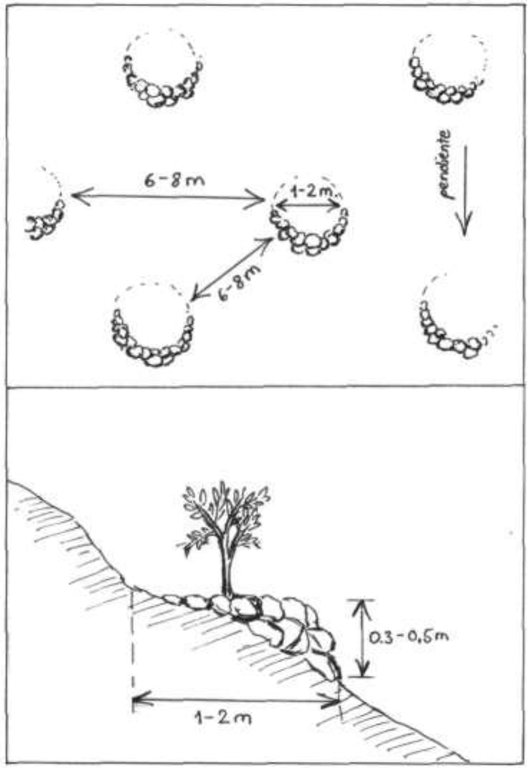Terrazas individuales [Nicaragua]
- Creation:
- Update:
- Compiler: Mathias Gurtner
- Editor: –
- Reviewer: Deborah Niggli
technologies_1565 - Nicaragua
View sections
Expand all Collapse all1. General information
1.2 Contact details of resource persons and institutions involved in the assessment and documentation of the Technology
SLM specialist:
SLM specialist:
Rodríguez Roger
Nicaragua
SLM specialist:
Chavama Jorge
FIDER
Nicaragua
1.3 Conditions regarding the use of data documented through WOCAT
The compiler and key resource person(s) accept the conditions regarding the use of data documented through WOCAT:
Ja
1.4 Declaration on sustainability of the described Technology
Is the Technology described here problematic with regard to land degradation, so that it cannot be declared a sustainable land management technology?
Nee
2. Description of the SLM Technology
2.1 Short description of the Technology
Definition of the Technology:
Pequeñas plataformas individuales, redondas o semi-circulares de aprox. 1 - 2 mts de diámetro trazadas a tresbolillo en cuyo centro se siembran normalmente árboles frutales.
2.2 Detailed description of the Technology
Description:
Pequeñas plataformas individuales (una terraza por árbol), redondas o semi-circulares de aprox. 1 - 2 mts de diámetro trazadas a tresbolillo en cuyo centro se siembran normalmente árboles frutales u otros cultivos perennes. Al igual que las demás terrazas, consisten en un corte y un relleno compactado pero no son continuas. La terraza se combina con muro de piedras al borde del relleno. La función principal es la conservación de humedad a través de la acumulación e infiltración del agua. Otra finalidad es un mejor aprovechamiento de los fertilizantes reduciendo la pérdida por la escorrentía. La ubicación de las terrazas en tresbolillos evita que el agua de la escorrentía tenga una sola dirección.
2.3 Photos of the Technology
2.5 Country/ region/ locations where the Technology has been applied and which are covered by this assessment
Country:
Nicaragua
Region/ State/ Province:
Estelí
Further specification of location:
Estelí, La Trinidad
2.6 Date of implementation
If precise year is not known, indicate approximate date:
- less than 10 years ago (recently)
2.7 Introduction of the Technology
Specify how the Technology was introduced:
- through projects/ external interventions
3. Classification of the SLM Technology
3.1 Main purpose(s) of the Technology
- reduce, prevent, restore land degradation
3.2 Current land use type(s) where the Technology is applied

Cropland
- Tree and shrub cropping
Comments:
Problemas principales del uso de tierras: Erosión severa en época de lluvia, baja fertilidad de la tierra, mal manejo de los recursos naturales, poco conocimiento sobre CSA, falte de seguridad de tierra (mediería), falta de recursos económicos, falta de organización comunitaria
3.3 Further information about land use
Water supply for the land on which the Technology is applied:
- mixed rainfed-irrigated
Number of growing seasons per year:
- 2
Specify:
100 días de Mayo hasta Agosto y 100 días de Agosto hasta Noviembre
3.4 SLM group to which the Technology belongs
- forest plantation management
- cross-slope measure
3.5 Spread of the Technology
Specify the spread of the Technology:
- evenly spread over an area
If the Technology is evenly spread over an area, indicate approximate area covered:
- 0.1-1 km2
3.6 SLM measures comprising the Technology

structural measures
- S1: Terraces
3.7 Main types of land degradation addressed by the Technology

soil erosion by water
- Wt: loss of topsoil/ surface erosion

chemical soil deterioration
- Cn: fertility decline and reduced organic matter content (not caused by erosion)

water degradation
- Ha: aridification
3.8 Prevention, reduction, or restoration of land degradation
Specify the goal of the Technology with regard to land degradation:
- prevent land degradation
- reduce land degradation
4. Technical specifications, implementation activities, inputs, and costs
4.1 Technical drawing of the Technology
4.2 Technical specifications/ explanations of technical drawing
Terrazas individuales de 1 - 2 metros de diámetro trazadas a tresbolillo para reducir la erosión. Distancia entre estructuras: 6 - 8 m.
Conocimientos técnicos necesarios para el personal / asesores de campo: medio
Conocimientos técnicos necesarios para los usuarios de la tierra: medio
Principales funciones técnicas: control de la escorrentía dispersa: impedir / retrasar, reducción del grado de la pendiente, reducción de la longitud de la pendiente, incremento de la infiltración
Funciones técnicas secundarias: incremento / mantenimiento del agua almacenada en el suelo, aumento de la fertilidad del suelo
4.3 General information regarding the calculation of inputs and costs
other/ national currency (specify):
Córdobas
Indicate exchange rate from USD to local currency (if relevant): 1 USD =:
12.5
Indicate average wage cost of hired labour per day:
2.00
4.4 Establishment activities
| Activity | Type of measure | Timing | |
|---|---|---|---|
| 1. | 1. Trazado: Con el aparato A se marcan curvas a nivel. La cinta métrica y el nivel de manila se usan para sacar la pendiente. | Structural | verano |
| 2. | 2. Marcado: Paralelamente con la curvas a nivel se inicia marcando el límite del corte y del relleno alrededor de la estaca de la curva a nivel o del árbol en el caso de cultivos establecidos. Se asegura que las terrazas quedan ubicadas a tresbolillos par | Structural | verano |
| 3. | 3. Construcción de la terraza: Se escarva la tierra arriba de este punto colocándola por debajo formando el relleno. Después de cada nueva capa de tierra suelta sobre el relleno se compacta el relleno. | Structural | verano |
| 4. | 4. Recolección de piedras | Structural | verano |
| 5. | 5. Construcción del talud de piedras: La base de la terraza se puede reforzar con piedras o barreras vivas | Structural | verano |
4.5 Costs and inputs needed for establishment
| Specify input | Unit | Quantity | Costs per Unit | Total costs per input | % of costs borne by land users | |
|---|---|---|---|---|---|---|
| Labour | Mano de obra | ha | 1.0 | 80.0 | 80.0 | 100.0 |
| Total costs for establishment of the Technology | 80.0 | |||||
4.6 Maintenance/ recurrent activities
| Activity | Type of measure | Timing/ frequency | |
|---|---|---|---|
| 1. | 1. En zonas secas se recomienda la aplicación de mulch en la terraza para mejorar la retención de húmedad. | Structural | Verano/1 vez por año |
| 2. | 2. Se recomienda revisar al inicio del invierno el drenaje lateral (desague). | Structural | nvierno (época de luvia)/2 veces por año |
| 3. | 3. Reubicación de piedras | Structural | Verano/1 vez por año |
| 4. | 4. Control de maleza | Structural | Cada seis meses |
4.7 Costs and inputs needed for maintenance/ recurrent activities (per year)
| Specify input | Unit | Quantity | Costs per Unit | Total costs per input | % of costs borne by land users | |
|---|---|---|---|---|---|---|
| Labour | mano de obra | ha | 1.0 | 6.0 | 6.0 | 100.0 |
| Total costs for maintenance of the Technology | 6.0 | |||||
Comments:
disponibildad de piedras, pendiente
4.8 Most important factors affecting the costs
Describe the most determinate factors affecting the costs:
disponibildad de piedras, pendiente
5. Natural and human environment
5.1 Climate
Annual rainfall
- < 250 mm
- 251-500 mm
- 501-750 mm
- 751-1,000 mm
- 1,001-1,500 mm
- 1,501-2,000 mm
- 2,001-3,000 mm
- 3,001-4,000 mm
- > 4,000 mm
Specifications/ comments on rainfall:
Se puede utilizar en todas las zonas climáticas. El efecto de conservación de agua es más importante en zonas secas. En zonas húmedas se recomienda un pequeño desague de cada terraza hacia un lado.
Agro-climatic zone
- sub-humid
- semi-arid
época de lluvia (mayo - octubre), alto riesgo de sequía, períodod seco julio/agosto
5.2 Topography
Slopes on average:
- flat (0-2%)
- gentle (3-5%)
- moderate (6-10%)
- rolling (11-15%)
- hilly (16-30%)
- steep (31-60%)
- very steep (>60%)
Landforms:
- plateau/plains
- ridges
- mountain slopes
- hill slopes
- footslopes
- valley floors
Altitudinal zone:
- 0-100 m a.s.l.
- 101-500 m a.s.l.
- 501-1,000 m a.s.l.
- 1,001-1,500 m a.s.l.
- 1,501-2,000 m a.s.l.
- 2,001-2,500 m a.s.l.
- 2,501-3,000 m a.s.l.
- 3,001-4,000 m a.s.l.
- > 4,000 m a.s.l.
5.3 Soils
Soil depth on average:
- very shallow (0-20 cm)
- shallow (21-50 cm)
- moderately deep (51-80 cm)
- deep (81-120 cm)
- very deep (> 120 cm)
Soil texture (topsoil):
- medium (loamy, silty)
- fine/ heavy (clay)
Topsoil organic matter:
- low (<1%)
5.6 Characteristics of land users applying the Technology
Market orientation of production system:
- mixed (subsistence/ commercial
Off-farm income:
- less than 10% of all income
Relative level of wealth:
- poor
Level of mechanization:
- manual work
- animal traction
Indicate other relevant characteristics of the land users:
Crecimiento anual de población: 3% - 4%
Especificación del ingreso fuera de la finca: Emigración y comercio
5.7 Average area of land owned or leased by land users applying the Technology
- < 0.5 ha
- 0.5-1 ha
- 1-2 ha
- 2-5 ha
- 5-15 ha
- 15-50 ha
- 50-100 ha
- 100-500 ha
- 500-1,000 ha
- 1,000-10,000 ha
- > 10,000 ha
5.8 Land ownership, land use rights, and water use rights
Land ownership:
- individual, not titled
- individual, titled
Land use rights:
- leased
- individual
6. Impacts and concluding statements
6.4 Cost-benefit analysis
How do the benefits compare with the establishment costs (from land users’ perspective)?
Short-term returns:
very negative
Long-term returns:
slightly positive
How do the benefits compare with the maintenance/ recurrent costs (from land users' perspective)?
Short-term returns:
positive
Long-term returns:
positive
6.5 Adoption of the Technology
Comments:
100% de las familias de usuarios de la tierra han adoptado la tecnología con soporte de material externo
6.7 Strengths/ advantages/ opportunities of the Technology
| Strengths/ advantages/ opportunities in the compiler’s or other key resource person’s view |
|---|
| Se ha dsiminuido el uso de fertilizantes |
| Mejora de la infiltración y permeabilidad del suelo, disminución de la erosión |
| acilita el manejo de los árboles / labores culturales |
6.8 Weaknesses/ disadvantages/ risks of the Technology and ways of overcoming them
| Weaknesses/ disadvantages/ risks in the compiler’s or other key resource person’s view | How can they be overcome? |
|---|---|
| Alta demanda de mano de obra (establecimiento) | Mano de vuelta, sensibilización, incentivos (plántulas) |
| Inseguridad de la tierra |
7. References and links
7.1 Methods/ sources of information
- field visits, field surveys
- interviews with land users
7.2 References to available publications
Title, author, year, ISBN:
Manual Práctico de Manejo de Suelos en Laderas. Secretaría de Recursos Naturales, Tegucigalpa, Honduras (LUPE). 1994.
Title, author, year, ISBN:
Inventario de las Técnicas de Conservación de Suelos y Agua. PASOLAC, Managua (PASOLAC). 1994.
Title, author, year, ISBN:
Inventario de Técnicas de Coonservación de Suelos y Agua de Laderas en Guatemala. PASOLAC, Managua (Velasquez, D. ). 1992.
Links and modules
Expand all Collapse allLinks
No links
Modules
No modules


